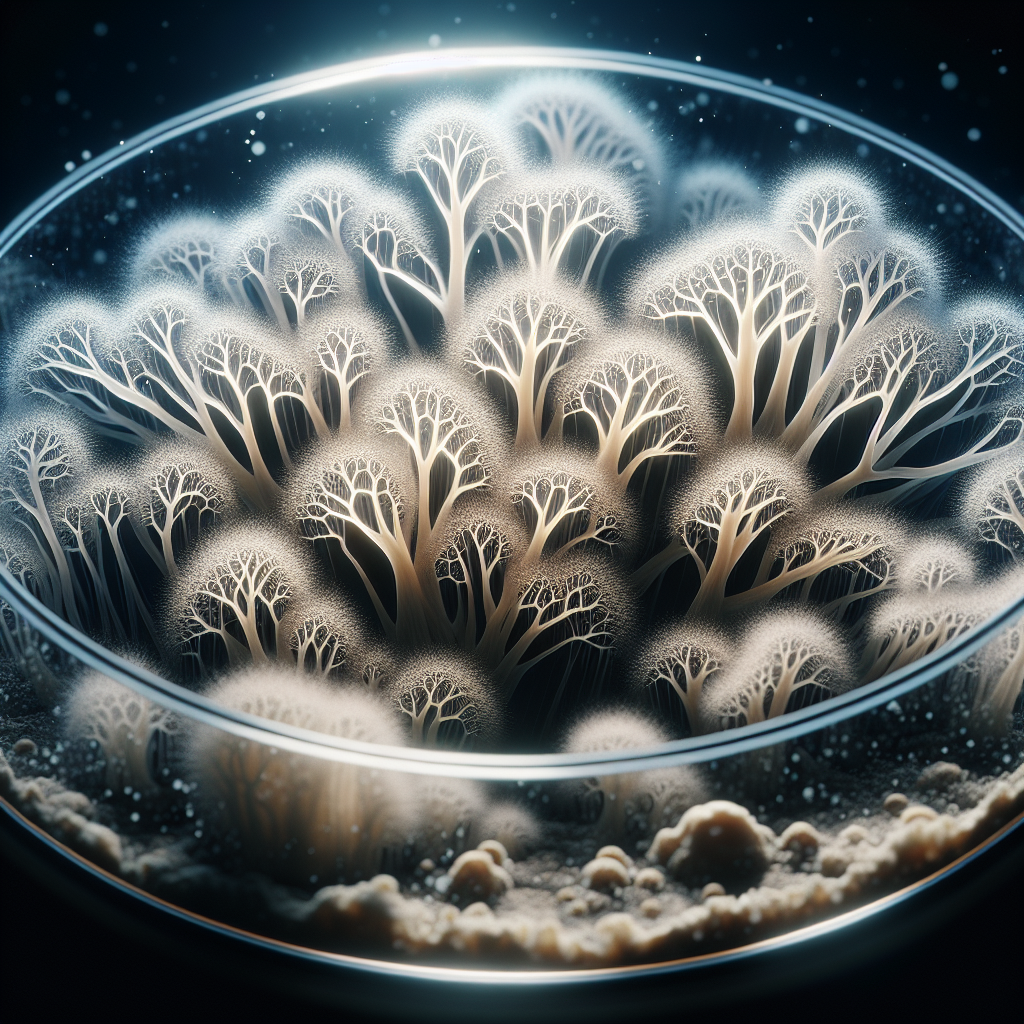In the world of biotechnology, there is a microcosm of life that often goes unnoticed. As an individual interested in this field, you have surely come across the term ‘mycelium’ – a fascinating organism that operates with much more complexity than its simplicity lets on. This article will open up your understanding of mycelium cultivation and its intricacies. You will gain insights on the symbiotic relationship between mycelium and the fruiting body, and how this connection can be harnessed for various applications in industry and science.

Understanding Mycelium and its Significance
Mycelium is the vegetative part of a fungus, consisting of a mass of branching, thread-like hyphae. Understanding mycelium is significant due to its versatile role in various sectors that are beneficial to human life and the ecosystem.
Defining mycelium
You may understand mycelium as the interconnecting network of filaments found in fungi. These microscopic fibers create a web-like structure that serves as the main growing body of the fungi, running underground or within different substrates.
Role of mycelium in the ecosystem
Mycelium plays a pivotal role in the ecosystem, particularly in the soil biosphere. It more or less acts like nature’s internet, connecting different plants and facilitating communication between them. By secreting enzymes that break down organic matter, mycelium helps recycle nutrients back into the ecosystem, promoting soil fertility.
Understanding the lifecycle of mycelium
The lifecycle of mycelium begins as a spore, which germinates to form a single-celled structure. These cells proceed to grow by sending out long germinating tubes, also known as hyphae. The network of these hyphae is what we refer to as ‘mycelium’. Over time, under the right conditions, this mycelium develops into a fruiting body, which is the familiar part of the fungus – the mushroom.
Types of Mycelium
Comparing edible and toxic species
There are numerous types of mycelium ranging from edible to toxic species. Some of the edible species include Button, Shiitake, and Oyster mushrooms, which possess culinary and medicinal values. However, other types are toxic and harmful when ingested, such as the Death Cap mushroom.
Variances in habitat and growth preferences
Different types of mycelium have varying preferences when it comes to their growth habitats. Some prefer to grow in a controlled environment like a greenhouse, while others flourish in the wild, forming symbiotic relationships with plants.
Utilization differences in various sectors
Mycelium has diverse usages across various spaces. For instance, in the food and beverage industry, it’s used in making beer, wine, and certain cuisines. It also holds significance in medical fields for its antibiotic properties, and in the agricultural field for its role in aiding soil enrichment.
The Basics of Mycelium Cultivation
Overview of mycelium cultivation
Mycelium cultivation is the process of growing fungi by providing suitable growth conditions for mycelium propagation. This involves inoculating a substrate with spores or a mycelium culture and maintaining a conducive environment for the growth of mycelium.
Understanding the growth requirements of mycelium
Mycelium have specific growth requirements including a nutritive and moist substrate, optimal temperature, appropriate pH level, and proper lighting. These conditions promote the growth and maturation of the mycelium into a fruiting body.
Importance of sterile techniques in mycelium cultivation
Sterile techniques in mycelium cultivation are crucial to prevent contamination caused by other organisms. This involves processes like pasteurization or sterilization to eliminate any potential organisms that might compete for nutrients and hinder mycelium growth.

Tools and Materials Required for Mycelium Cultivation
Listing the necessary equipment and resources
Cultivating mycelium requires various tools and resources, including a sterile cultivation medium, glass jars, pressure cooker, gloves, facemask, inoculation loop, spore syringe, and a heating pad among others.
Roles and importance of each tool in cultivation
Each tool plays a vital role in the cultivation process. For instance, the pressure cooker is used for sterilizing materials, inoculation loops for transferring the mycelium, gloves and facemask for maintaining hygiene and preventing contamination.
Safe handling and maintenance of tools and materials
Safe handling and maintenance of tools and materials is equally important. This involves cleaning and sanitizing tools before and after use, maintaining a clean working environment, and following safety guidelines to avoid any harm or contamination to the mycelium.
Preparation Steps before Starting Mycelium Cultivation
Choosing a suitable species for cultivation
The first step in mycelium cultivation involves choosing a suitable species to cultivate. This choice depends on many factors, such as the intended use of the mushroom, its adaptability to the available growing conditions, and its pace of growth.
Preparing the cultivation medium
Next, you prepare the cultivation medium – a nutritive substance where your mycelium will grow. This could range from organic materials like straw, wood, or compost.
Creating a conducive environment for mycelium growth
Finally, creating a conducive environment for mycelium growth involves maintaining the right temperature, humidity, and lighting conditions. It also requires frequent monitoring and adjustments to meet the growth needs of the mycelium.
Steps to Propagate Mycelium at Home
Inoculating the substrate with mycelium spores
Once your substrate is ready, the next step involves inoculating it with mycelium spores or a mycelium culture. This is done under sterile conditions to ensure the successful growth of the mycelium.
Maintaining optimal growing conditions
After inoculation, maintaining optimal growing conditions is vital. These conditions include consistent temperature, adequate moisture, proper air exchange, and appropriate lighting.
Monitoring growth and troubleshooting common issues
Monitoring growth involves checking for signs of mycelium colonization, like a white, cotton-like growth on your substrate. Troubleshooting involves identifying and addressing common issues like contamination, slow growth, or failure to fruit.
Harvesting and Post-Cultivation Processes
Identifying signs of mycelium readiness for harvest
Harvesting is determined by the appearance of a mature fruiting body. These signs may vary among species but generally include a fully expanded cap and the separation of the gills from the stem.
Safe and efficient harvesting techniques
Harvesting techniques involve gently twisting the fruiting body off the substrate or cutting it at the base to avoid disturbing the mycelium. It’s crucial to carry out this process with clean hands or gloves to avoid any form of contamination.
Post-harvesting care and maintenance for continuous cultivation
Post-harvest care involves rehydrating the substrate for another fruiting cycle and maintaining the sterile conditions. Continuous monitoring and removal of any signs of contamination are also key to ensuring success in the subsequent cycles.
Benefits and Applications of Cultivated Mycelium
Utilization of mycelium in the culinary industry
Mycelium from some edible mushroom species is used in the culinary industry, where it’s considered a delicacy due to its unique tastes and textures. Additionally, it offers various nutritional benefits, such as being a good source of protein, vitamins, and fiber.
Mycelium and its role in manufacturing biodegradable materials
In the manufacturing sector, mycelium has paved the way for creating biodegradable materials. For instance, mycelium-based packaging materials and mycelium ‘leather’ are some of the eco-friendly products gaining popularity in the industry.
Role of mycelium in medicine and pharmacology
Mycelium has been widely studied in medicine for its potent antimicrobial, anticancer, and immunomodulatory properties. Various mycelium-based drugs are being developed and utilized in the field of pharmacology.
Diseases and Pests affecting Mycelium Growth
Common diseases impacting mycelium
Mycelium can be affected by a number of diseases, most of which are caused by other competing microorganisms. Some common diseases include mold contamination, bacterial blotch, dry bubble disease, and Trichoderma.
Typical pests that pose threats to mycelium
In addition to diseases, pests can also impact mycelium growth. Common pests include flies, mites, nematodes and slugs. These pests can damage the mycelium directly or introduce harmful pathogens.
Prevention and control strategies for diseases and pests
Strategies for preventing and controlling diseases and pests include maintaining sterile conditions, regular monitoring for early detection, isolation of infected cultures, and appropriate use of biological or chemical controls.
Future Trends and Prospects of Mycelium Cultivation
Current innovative applications of cultivated mycelium
Mycelium is currently being explored in various innovative ways. This includes its use in bio-art, architecture, and mycoremediation, where it’s used to decontaminate polluted areas.
Future prospects in the field of mycelium cultivation
The field of mycelium cultivation holds promising prospects. With the increasing demand for sustainable and eco-friendly alternatives in various sectors, mycelium is bound to play a significant role in the future.
Challenges and potential solutions in large-scale mycelium cultivation
Despite the potential, large-scale mycelium cultivation faces multiple challenges, such as the requirement of precise growing conditions, risk of contamination, and high production costs. However, innovative technologies and research can potentially provide solutions to these challenges.
